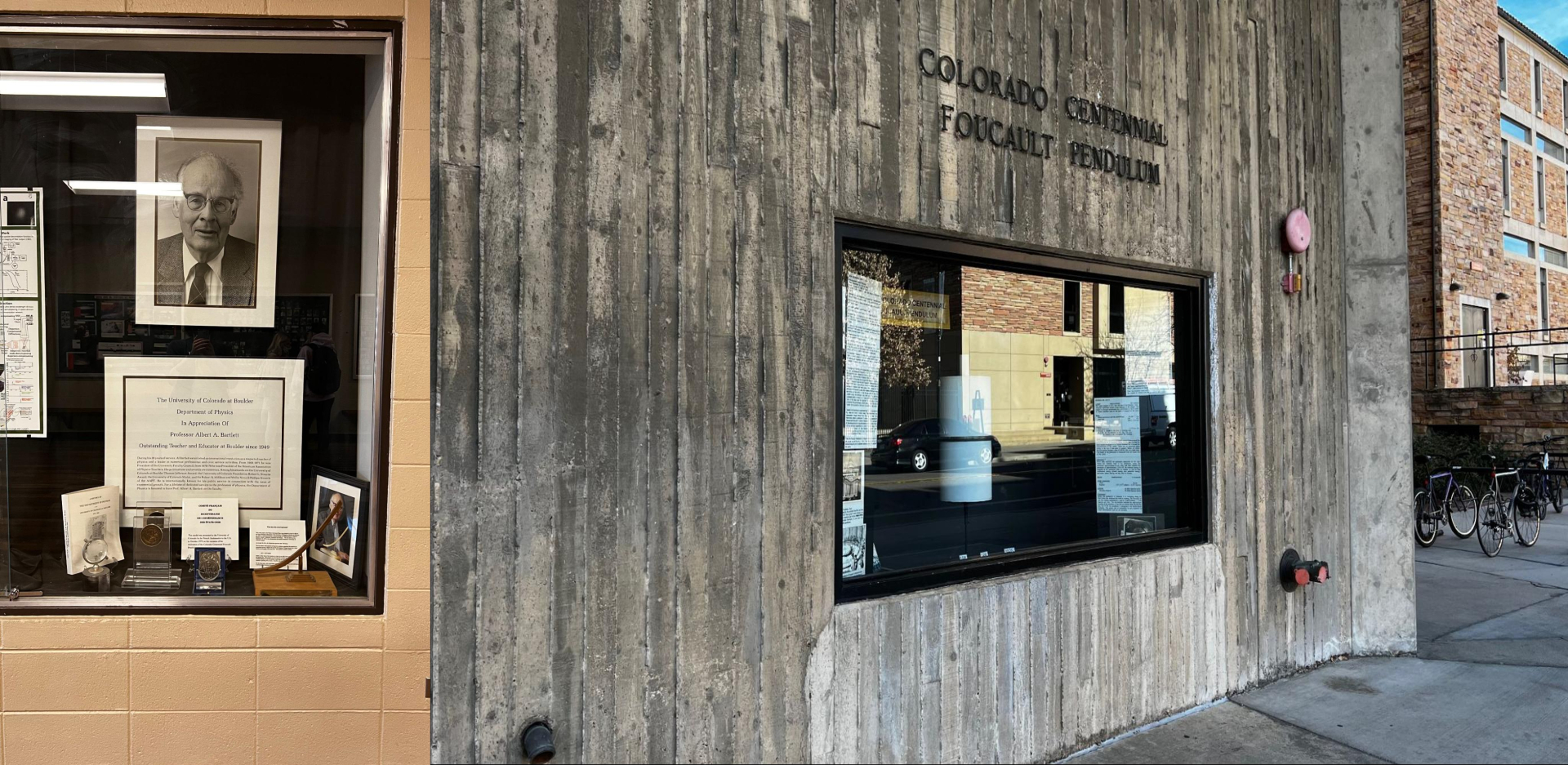The Swingiest Sight of CU Boulder
My personal discovery of CU's pendulum and the history behind it.
When I arrived at the University of Colorado Boulder, COVID-19 was in full swing. On the rare occasion I came to campus, I made sure to walk around and familiarize myself with the sights. Varsity Pond, Old Main, the massive Folsom Field, the ATLAS lighthouse, and more. On all these lists I would look up, all the suggestions my friends and lab-mates gave me, not one mentioned the Foucault pendulum.
One day, as I walked back from the ATLAS institute, I thought about my previous life in physics. I got my B.Sc. in physics from Johns Hopkins, where we were building the James Webb space telescope, the Cosmology Large Angular Scale Surveyor telescopes, and various other scientific instruments. I used to spend almost every waking hour in my alma mater’s physics building, either doing research or studying, and I now missed the scent of chalk and oil. Fueled by this nostalgia, I ventured towards CU’s Duane Physics Building.
Imagine my surprise when I saw the Colorado Centennial Foucault Pendulum swinging proudly in the daylight.
Like a kid watching sharks swim by in an aquarium, I pressed my face up against the glass, trying to read the plaques. This Foucault pendulum was built in 1976 after the completion of Gamow Tower, marking the 200th anniversary of the founding of the United States, the 125th anniversary of the first Foucault pendulum, and the 100th anniversary of the state of Colorado and the University of Colorado.
While those are all cool anniversaries, I was much more curious to know how this Foucault pendulum compared to others in the US and abroad. After some digging, data revealed that this unassuming, dusty chunk of lead dangling from a wire inside the air shaft of Gamow Tower is the largest operating pendulum in the western hemisphere, and second in the world only to the original Foucault pendulum in Paris’s pantheon. This hemisphere’s largest Foucault Pendulum is right here on campus: and nobody knows about it.

The What

The Colorado Centennial Foucault pendulum stands at 39.4 meters (129.3 feet) tall. It spans the entire height of Gamow Tower, hooked up to an intricate mechanism on the 14th floor. The mass at the bottom end of the pendulum weighs in at around 167.3 kilograms (368.83 pounds). Every morning, the Foucault pendulum is reset by a mechanism at its base and, as it swings throughout the day, it tells the time. It is essentially one of the world’s largest and least complicated clocks, but with the coolest of stories behind it.
While regular pendula showcase conservation of energy, Foucault pendula slightly different: they showcase the rotation of the earth around its axis.
Just like a normal pendulum, a Foucault pendulum is a heavy mass at the end of a string or rod. What makes Foucault pendulums special are that they exist on the end of an especially long string.
This extra length allows its rotation perpendicular to its swinging plane to be fully visible. This rotation happens because the pendulum experiences no external forces, and, as the earth rotates below the swinging mass, the mass stays put.
Foucault pendula have been around since 1851 when the French physicist Jean-Bernard-Leon Foucault built the first at the Pantheon in Paris. The pendulum was started and, as the day progressed, the pendulum rotated. Given what we know about conservation of energy, this rotation of the pendulum should not have been possible unless it was not the pendulum rotating, but rather us rotating around the pendulum.
The How
In physics education, pendula are taught in conjunction with conservation of energy. A common demonstration for conservation of energy involved a bowling ball and a volunteer. The volunteer sat at the front of the class and the professor would pull the bowling ball, which was attached to the ceiling on a string, up to the volunteer’s face. The professor would then drop the ball, asking the volunteer, “How much do you trust physics?” The ball would reach its maximum at the other side of the swing, come back down, and swing right back to the volunteer’s face, stopping mere centimeters from their nose.

Imagine the bowling ball can only move in two dimensions, left/right and up/down. Since the arm is at a set length, as the bob is pushed left it also moves up. As the ball moves up, it gains what we call gravitational potential energy. When released, the ball swings down, and that potential energy is converted into kinetic energy in the form of speed. At the bottom of its ark, all the ball’s potential energy has been converted into speed. The ball swings through and continues upwards to the right, decreasing its kinetic energy and adding to its potential energy. For a brief moment, it will stop at a maximum height on the right side that should match the height the ball was originally pulled to the left, before falling back down and continuing swinging.
Because the bob can never move higher than the original point it was dropped from, the demonstrator was 100 percent confident that the volunteer would walk away with their nose intact. With a Foucault pendulum, though no one’s face aesthetics are at risk, the concepts above remain the same with only one exception: the arm of the pendulum is very, very long.
Due to the length of the string and the lack of other external forces, the rotation of the earth becomes visible as a Foucault pendulum begins to nutate perpendicular to its original motion. Basically, during every swing the pendulum will move a little bit to the right (in the northern hemisphere. It moves to the left in the southern hemisphere).
The Why
The next question to ask is, “why here?”
Unlike the pendula in Griffiths Park or Fermi labs, CU is not a museum nor a national lab. And while the French Ambassador did speak at the pendulum’s unveiling, it was not a gift from another nation like the pendulum at the U.N. building in New York City. Instead, this pendulum is the brainchild of one Albert Bartlett, a giant in physics, population, and sustainability at CU and in the world at large.

Born in 1923, Bartlett came of age during World War II. Before even getting his Ph.D., he worked for Los Alamos studying the properties of plutonium and photographing atomic explosions. Post-PhD., he began teaching at the University of Colorado Boulder.
Bartlett quickly became a known name in the community, actively pursuing novel teaching methods while lobbying local politicians to maintain open space around Boulder. According to Dr. Stephen Wagner, Professor Attendant Rank and the current caretaker for the pendulum, Bartlett implemented the rotating fronts to lecture halls in Duane, as well as came up with the idea for the pendulum.
The story from Wagner goes, “Al was just this universal good guy. When CU was building Gamow Tower, he noticed this airshaft and decided to build a pendulum. He would do all the work himself, all he asked was for a window to be put to allow passersby to experience it.” The physics department went along with it, and after everything was built and installed, he was the one to start the pendulum’s first oscillations.
Though a brilliant idea, not even the most renowned physicists are infallible. A few months after the pendulums’ installment, one issue arose: the piano wire the pendulum was hanging from was stretching. Bartlett being Bartlett, this stretching had already been thought of and a mechanism at the top was already in place to pull the string up.
Unfortunately, it was stretching faster than expected. This would mean that someone in the relatively near future (within 20 years or so) would have had to replace the entire wire system and rehang the pendulum, an extremely arduous task.
If you look closely at the pendulum, you may notice the bob at the end has a metal piece in the middle of it. Bartlett’s solution for the stretching problem was to put half the mass as originally planned in the lead bob at the bottom. This prolonged the pendulum’s lifespan and did not affect its nutation, save for a little less resistance to air friction. Nowadays, the pendulum’s biggest problems are the pigeons that sometimes invade the air shaft and shed over the display.
The Extra
During the construction of any Foucault pendula, one of the first questions that needed to be answered is “how will this pendulum operate?” There are two ways to make this happen: A magnetic ‘driver’ being placed at the top that provides a small electromagnetic kick every swing to counteract air resistance, or a mechanism that restarts the pendulum every day after it has stopped due to air resistance (or, technically, put the pendulum in a vacuum. Unfortunately, this is very, very hard to do on earth). While a permanently swinging pendulum sounds appealing, Bartlett wanted the pendulum to exist in its purest form as to disprove even the most skeptical.
Despite Foucault pendula being accepted even by The Roman Catholic Church as proof that the earth is round and rotating, some Flat Earthers still disagree. Among these individuals are two main camps: one that believes the Foucault pendulum is rotating but is doing so because of universal motion, a “magnetic universal Coriolis Effect”, and the other believes Foucault pendula are all smoke and mirrors. Knowing about both fallacies, Bartlett kept the pendulum undriven and filled the bob at the base with lead, a non-magnetic material. Thus, not even the most doubtful can deny our pendulum’s display of the earth’s rotation.
The End
As I walk through campus now, I go out of my way to pass by the pendulum whenever I can. I take a minute to stare, watching its unbridled motion for a few minutes while a song on my headphones ends or I wait for my bus to arrive. Sometimes I will bring a friend along and giddily explain the theory and history of this one-of-a-kind trinket of the western hemisphere. Other students rush by, paying no mind as I poorly gesticulate motion in three dimensions. One day, this achievement of the University of Colorado Boulder will be given the spotlight it deserves. Wagner has plans to spruce up the visual aids around the pendulum, making for a more eye-catching experience, and the Physics Education Research group hopes to add further demos using sand or dominos to create a more interactive experience. But for now, the pendulum will just swing undisturbed, observed only through the glass by curious strangers and nerds like me, as it has been for the past 45 years.

